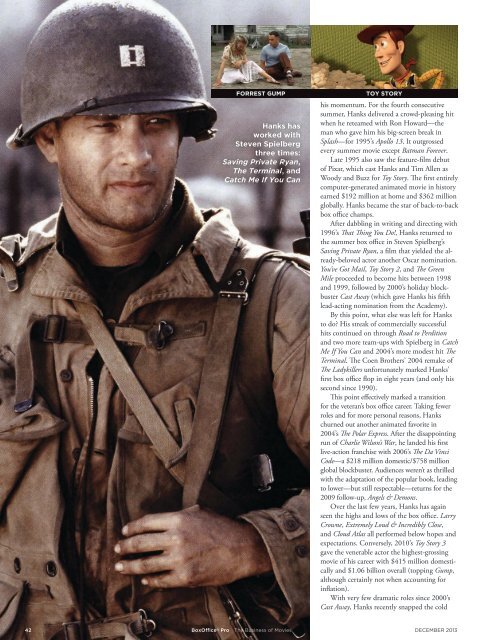Boxoffice® Pro - December 2013
You also want an ePaper? Increase the reach of your titles
YUMPU automatically turns print PDFs into web optimized ePapers that Google loves.
FORREST GUMP<br />
Hanks has<br />
worked with<br />
Steven Spielberg<br />
three times:<br />
Saving Private Ryan,<br />
The Terminal, and<br />
Catch Me If You Can<br />
TOY STORY<br />
his momentum. For the fourth consecutive<br />
summer, Hanks delivered a crowd-pleasing hit<br />
when he reteamed with Ron Howard—the<br />
man who gave him his big-screen break in<br />
Splash—for 1995’s Apollo 13. It outgrossed<br />
every summer movie except Batman Forever.<br />
Late 1995 also saw the feature-film debut<br />
of Pixar, which cast Hanks and Tim Allen as<br />
Woody and Buzz for Toy Story. The first entirely<br />
computer-generated animated movie in history<br />
earned $192 million at home and $362 million<br />
globally. Hanks became the star of back-to-back<br />
box office champs.<br />
After dabbling in writing and directing with<br />
1996’s That Thing You Do!, Hanks returned to<br />
the summer box office in Steven Spielberg’s<br />
Saving Private Ryan, a film that yielded the already-beloved<br />
actor another Oscar nomination.<br />
You’ve Got Mail, Toy Story 2, and The Green<br />
Mile proceeded to become hits between 1998<br />
and 1999, followed by 2000’s holiday blockbuster<br />
Cast Away (which gave Hanks his fifth<br />
lead-acting nomination from the Academy).<br />
By this point, what else was left for Hanks<br />
to do? His streak of commercially successful<br />
hits continued on through Road to Perdition<br />
and two more team-ups with Spielberg in Catch<br />
Me If You Can and 2004’s more modest hit The<br />
Terminal. The Coen Brothers’ 2004 remake of<br />
The Ladykillers unfortunately marked Hanks’<br />
first box office flop in eight years (and only his<br />
second since 1990).<br />
This point effectively marked a transition<br />
for the veteran’s box office career. Taking fewer<br />
roles and for more personal reasons, Hanks<br />
churned out another animated favorite in<br />
2004’s The Polar Express. After the disappointing<br />
run of Charlie Wilson’s War, he landed his first<br />
live-action franchise with 2006’s The Da Vinci<br />
Code—a $218 million domestic/$758 million<br />
global blockbuster. Audiences weren’t as thrilled<br />
with the adaptation of the popular book, leading<br />
to lower—but still respectable—returns for the<br />
2009 follow-up, Angels & Demons.<br />
Over the last few years, Hanks has again<br />
seen the highs and lows of the box office. Larry<br />
Crowne, Extremely Loud & Incredibly Close,<br />
and Cloud Atlas all performed below hopes and<br />
expectations. Conversely, 2010’s Toy Story 3<br />
gave the venerable actor the highest-grossing<br />
movie of his career with $415 million domestically<br />
and $1.06 billion overall (topping Gump,<br />
although certainly not when accounting for<br />
inflation).<br />
With very few dramatic roles since 2000’s<br />
Cast Away, Hanks recently snapped the cold<br />
42 BoxOffice ® <strong>Pro</strong> The Business of Movies DECEMBER <strong>2013</strong>

















